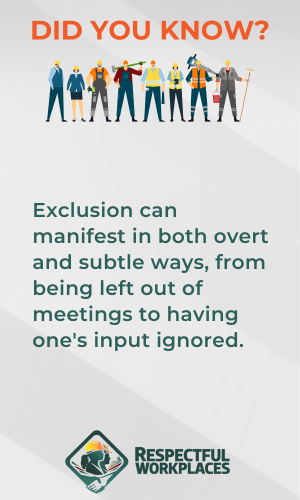Exclusion manifests in various forms, including social, workplace, and educational settings, and it has far-reaching consequences for individuals and communities.
Exclusion can lead to isolation and diminished mental health and can result in reduced productivity and job satisfaction. By leading by example, individuals and organizations can foster environments where everyone feels valued and respected. Taking a stand against exclusion benefits those directly affected and strengthens the fabric of society as a whole.

Recognizing Exclusion: Identifying the Subtle Signs
Exclusion can manifest in both overt and subtle ways, making it crucial to recognize these signs. Overt exclusion is often blatant, such as intentionally leaving someone out of meetings or group activities. In contrast, subtle exclusion might involve consistently ignoring someone’s input or unintentionally favoring certain individuals. These subtle acts can be just as harmful, gradually eroding an individual’s sense of belonging. Unconscious bias plays a significant role, as it often drives these behaviors without the perpetrator’s awareness. For instance, a teacher might unconsciously call on male students more often than female students, perpetuating gender exclusion.
Taking Action: Practical Steps to Stand Up to Exclusion
Taking action against exclusion requires a multifaceted approach, beginning with self-education and awareness. Understanding different cultures and perspectives is foundational, broadening one’s worldview and fostering empathy. Inclusive leadership involves speaking up when witnessing exclusion, addressing the issue respectfully, using strategies like private conversations, or bringing attention to exclusion to encourage change. Inclusive decision-making ensures that diverse voices are heard in virtual and physical spaces, helping create environments where everyone feels valued. Supporting others by being an ally is crucial—whether in the workplace or within social settings, encouraging others to stand up against exclusion amplifies the impact of these efforts. Together, these actions create a ripple effect, promoting inclusivity across organizations.
Overcoming Challenges: Handling Pushback
Standing up to exclusion often comes with challenges, including resistance or backlash from those who may not understand or agree with the need for change. Common challenges include pushback from peers or leadership and the emotional toll of confronting exclusion. Practical strategies for managing this resistance include staying calm, focusing on the facts, and seeking support from allies. Resilience is critical in leading by example; it involves maintaining a commitment to inclusivity even when faced with setbacks. Canadian leaders, such as Arlene Dickinson, have demonstrated the importance of resilience in fostering inclusive environments. Rather than being discouraged by them, learning from setbacks allows individuals to refine their approaches and continue advocating for inclusion. By persevering, leaders can inspire others to do the same.
The Ripple Effect: The Long-Term Impact of Inclusive Leadership
Inclusive leadership has a powerful ripple effect that extends far beyond the immediate actions of an individual. When leaders lead by example, they inspire others to adopt inclusive behaviors, creating a chain reaction that can transform workplaces and communities. In Canada, the success of diversity and inclusion programs at RBC illustrates how inclusive leadership can drive significant change, influencing both corporate culture and societal norms. Similarly, in the US, initiatives led by companies such as Salesforce show how small, everyday actions by leaders can lead to broader societal impact. These case studies demonstrate that fostering an inclusive environment doesn’t just benefit the individuals involved; it helps create a more equitable society. Continuous learning and adaptation are essential, as they ensure that both personal and professional practices evolve to meet the needs of an increasingly diverse world.
Your Role in Fostering an Inclusive Culture
Fostering an inclusive culture starts with individual actions, but its impact can extend far beyond. Leading by example is vital in standing up to exclusion. Each action contributes to a more inclusive environment, from recognizing subtle signs of exclusion to taking proactive steps and handling challenges. Everyone can make a difference in the workplace, community, or personal life. Individuals can commit to leading by example, thereby inspiring others to do the same.
Michael Bach is an author and speaker, a thought leader in inclusion, diversity, equity, and accessibility, and an IDEA consultant to BuildForce Canada.

Respectful and Inclusive Workplaces
